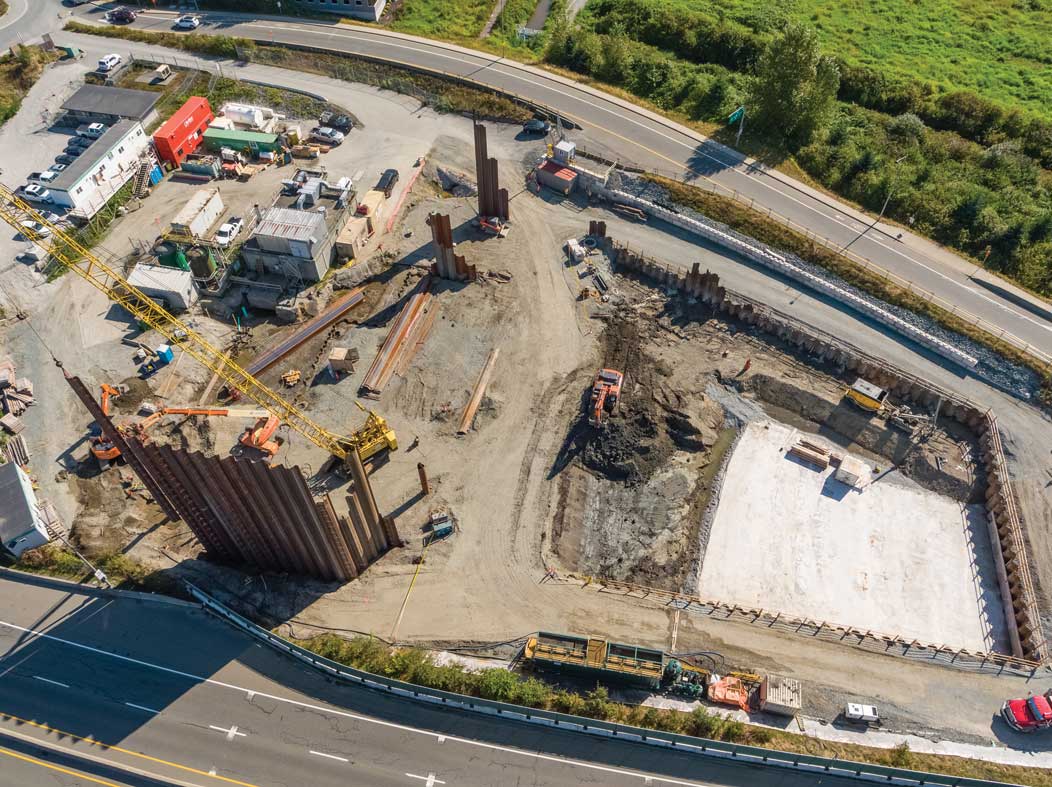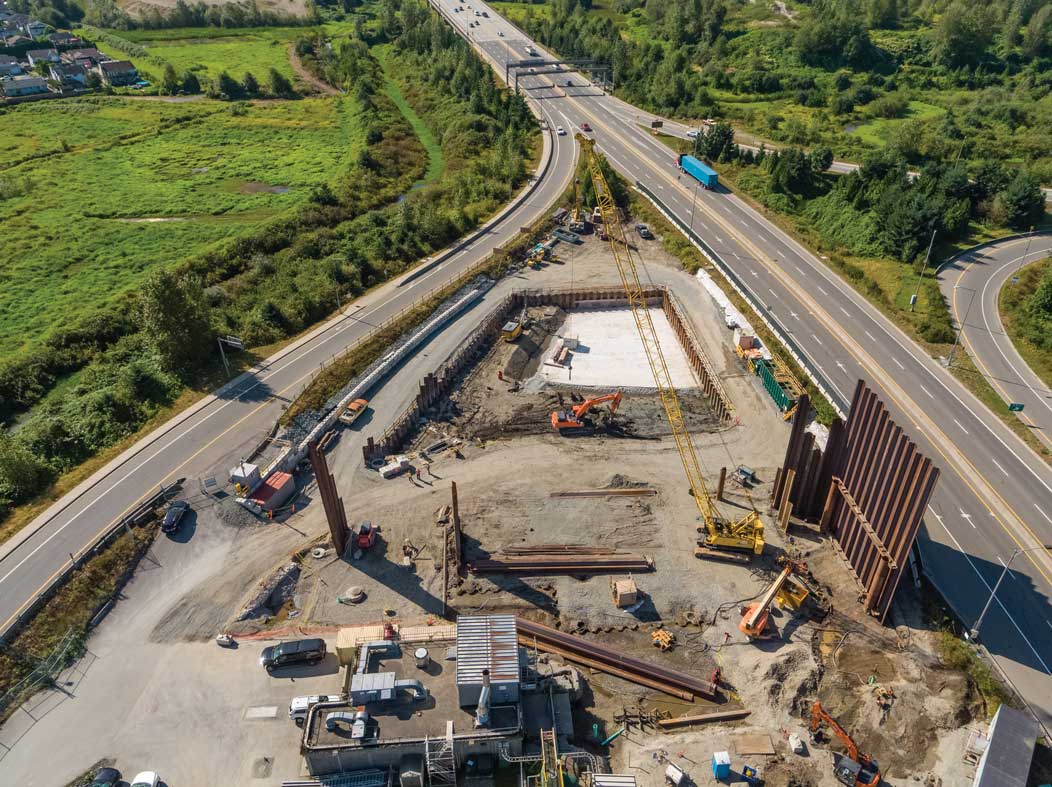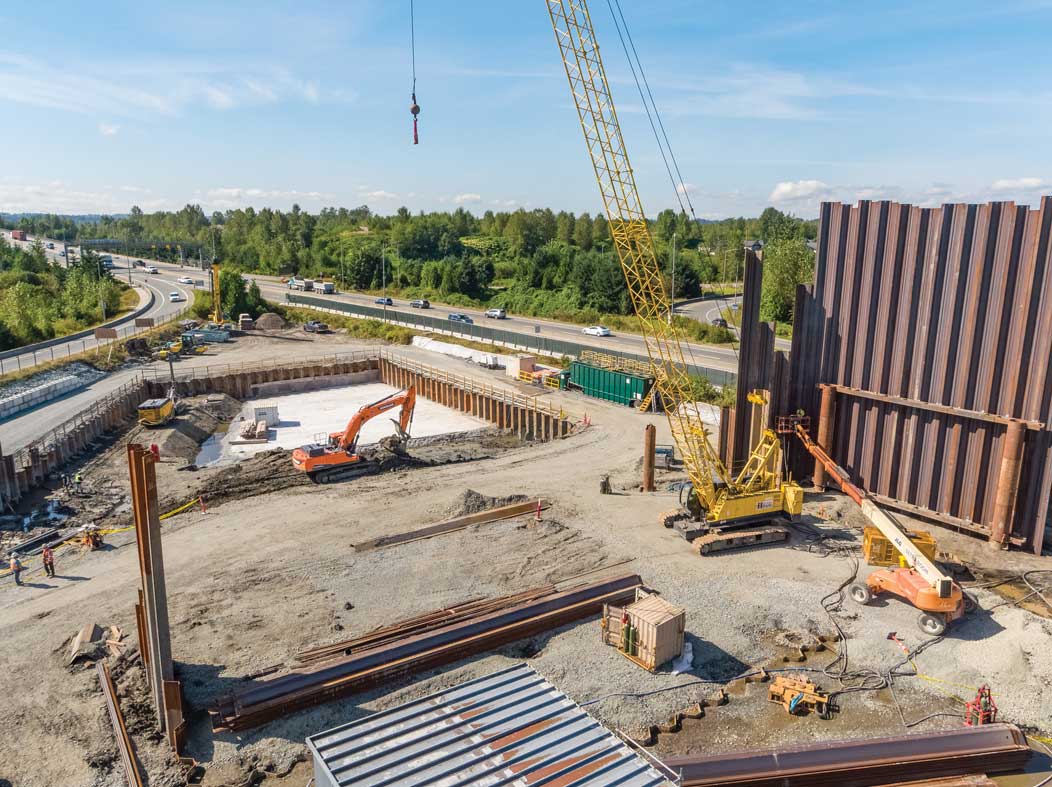
A new pump station near Golden Ears Way and 113B Avenue in Maple Ridge, B.C., will replace an existing facility and help move wastewater from Maple Ridge and Pitt Meadows to the treatment plant in the Township of Langley. The new pump station will replace the existing Katzie Pump Station and support the upcoming Northwest Langley Wastewater Treatment Plant expansion.
The new storage tank, next to the pump station, will temporarily store wastewater to prevent overflows during storms. The project includes architectural design elements such as large feature windows on the pump station facade and vertical precast concrete fins suspended from the concrete walls around the pump station. Excavation began in spring 2020, with above-ground work underway this past spring. The project will finish in winter 2022.
Henry Foundation Drilling, Inc. (HFDI) designed a cost-effective shoring solution that would also act as a water cut-off for the project. HFDI completed the sheet pile and steelwork installation while Southwest Contracting, Ltd., installed the anchors.
The cost of the entire sewer and water project is estimated at $1.3 billion. The project tab is being shared by all Metro Vancouver member jurisdictions that are part of the Greater Vancouver Sewerage and Drainage District. The pump station and adjacent Sanitary Sewer Overflow tank are projected to cost about $70 million at build-out. Katzie First Nation artist, Trenton Pierre, who has earned praise for local murals, has been awarded the contract to create a full-wall design on the south wall of the storage tank.

Community input for the project was ongoing and inclusive. Reports show that consultations took place in a series of three open houses held between 2017 and 2019, and project managers listened. For instance, to minimize the impact of traffic, noise and dust during construction, large truck traffic was limited to between 9 a.m. and 3 p.m., and there were minimal road closures.
“The Northwest Langley Wastewater Treatment Plant currently provides wastewater treatment to 30,000 people in Langley and is being expanded to also serve the communities of Maple Ridge and Pitt Meadows – up to 230,000 people,” said Cheryl Nelms, general manager of project delivery, Metro Vancouver. “The project will help meet the needs of the growing population, strengthen the system’s resilience to seismic events and the effects of climate change, reduce odours, recover energy and resources from wastewater and meet updated federal regulations.”
According to Alexandre Alves, project manager at HFDI, the project consisted of the design, supply and installation of a temporary excavation shoring system to allow the installation of the future Golden Ears Pump Station. Shoring consisted of a driven sheet pile system braced with a combination of internal bracing, tie-rods and tie-backs to a maximum excavation depth of 11 metres. A total of 278 pairs of sheets were installed with lengths up to 80 feet. The shoring system also acted as a water cut-off. This system reduced the ingress of groundwater into the future facility, resulting in less costly water management for the owner and enabling more sustainable use of aquifer resources.
Shoring consisted of a driven sheet pile system braced with a combination of internal bracing, tie-rods and tie-backs to a maximum excavation depth of 11 metres. Alves says that the project, while smooth in delivery, did come with challenges.
“The project was very close and in proximity to Golden Ears Way, a busy road connecting Maple Ridge and Pitt Meadows to Langley and Surrey. It was also very close to the existing Katzie Pump Station,” he said.
In addition to proximity issues, there were several changes to the design required by the client during construction. “These changes required agility and a lot of technical expertise from our design-build team,” Alves said.
The Golden Ears Pump Station project engineers turned to shoring methods to complete the job. Shoring is commonly seen in port and harbour construction and is best used when crews need to isolate their excavation from bodies of water such as a creek, pond or ocean shore. Similar to a soldier pile retaining wall, shoring can be constructed by driving steel sheet piles into the ground using a vibro hammer. The wall is formed by connecting the Z or U connectors of the sheet piles.
To get the job done, HFDI designed a robust engineered frame system to hold the sheets in place during staggered driving. This technique ensured the sheets were installed within construction tolerances and maintained proper interlock during driving. The frame was supported by temporary pipes. Alves says the embedment depth was a function of the wind speed and the number of sheet pile pairs.

“We welded 70-foot to 80-foot sheets that were around 25 feet tall, to make sure that the two pipe piles would have enough embedment into the ground to resist the shear forces and bending movements transferred to the pipe piles as a result of the wind forces,” he said.
Describing the robust nature of the frame, Alves says the structure was comprised of steel beams welded to two 25-feet-tall steel pipes. “The bolt connections were required to ‘split’ the frame so we could transport it to the site,” he said, stating that the installation procedure was as follows:
- Prepare a stable working platform before sheet pile installation.
- Install two pipe piles (30-inch OD with 3/8-inch-thick wall); horizontal spacing between the two pipe piles was approximately 48.5 feet.
- Hoist sheet pile frame onto the two pipe piles. The frame consisted of two piles with larger diameter pipes than the driven piles. Attached to these were two horizontal W24×117 beams at 15- and 28-feet from grade, respectively.
- The sheet piles were welded to the frame at the beams’ locations (the frame could hold up to 10 sheets).
- The sheet piles were then driven into the ground.
On site, HFDI crews used their lattice crawler crane with a 180-foot boom with an APE Model 150T vibratory driver. A Gardner Denver ADT 3800 air track drill, supplied by Southwest Contractors was also used. The AZ19-700 and PCZ26 sheet piles were supplied by Samuel Roll Form Group through Titan Tube and Metal.
Alves says on-site testing was all part of the process. For example, the shoring system was designed, installed and maintained to prevent detrimental settlement and lateral movement of existing facilities, adjacent properties and completed works. “Inclinometers, survey targets and tiltmeters were installed by the general contractor to monitor movement and settlement. Geophones were also used for vibration monitoring,” he said. Several environmental sustainability measures were placed as well.
“The greatest benefit to the environment was the installation of the water cut-off system. The reduction of water ingress into the construction site allows a more manageable and sustainable use of aquifers and reduces the migration of contaminants that can be initiated or exacerbated by extraction/diversion,” Alves said, concluding that the project is a major step in moving water treatment forward in B.C.’s Lower Mainland.